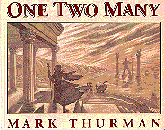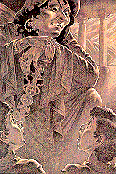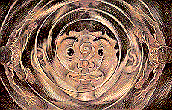

![]()

|
One Two Many.
Mark Thurman.
Grades K - 2 / Ages 5 - 7.
*/4
|
excerpt:
At the Temple, the Keeper beckoned the boys to her. ``Well, well, what have we here . . . trouble? Double trouble?? When one becomes two, the desire to part is very, very strong. There is but one way to solve this division. A journey. You must work together, stay together, for only together are you complete and strong. Apart, all is lost."
``You wished for something and you got it," said the Keeper to the boys. ``Now you must see it through to the end. You must go to Double Isle.
``Take these three things: this flint torch, this feather, and this bag of pebbles. The journey will reveal their use." She pointed out over the sea, beyond the guardian of the city. ``Now go."
 One Two Many, originally published in hard cover in 1993,
is now released in paperback. The title is a play on words because when
Jan's reflection comes to life, Jan discovers that two is one too many.
The boys are exactly alike, with each believing he is the real Jan. They
decide to resolve their problem by consulting the Keeper of the Keys, who
sends them on a journey in which they must solve a riddle, find their way
through a maze, and overcome a two-headed giant. Many elements of fantasy
and mythology are here: the quest, the intervention of a wise person
with mysterious clues, the obstacles to be overcome, and the resolution
by using one's wits.
One Two Many, originally published in hard cover in 1993,
is now released in paperback. The title is a play on words because when
Jan's reflection comes to life, Jan discovers that two is one too many.
The boys are exactly alike, with each believing he is the real Jan. They
decide to resolve their problem by consulting the Keeper of the Keys, who
sends them on a journey in which they must solve a riddle, find their way
through a maze, and overcome a two-headed giant. Many elements of fantasy
and mythology are here: the quest, the intervention of a wise person
with mysterious clues, the obstacles to be overcome, and the resolution
by using one's wits.

Marginal purchase.
Alison Mews is Coordinator at the Centre for Instructional Services in the Faculty of Education at Memorial University of Newfoundland.
To comment on this title or this review, send mail to cmeditor@mts.net.
![]()
Copyright © 1996 the Manitoba Library Association.
Reproduction for personal use is permitted only if this copyright notice
is maintained. Any other reproduction is prohibited without permission.
Published by
The Manitoba Library Association
ISSN 1201-9364
![]()